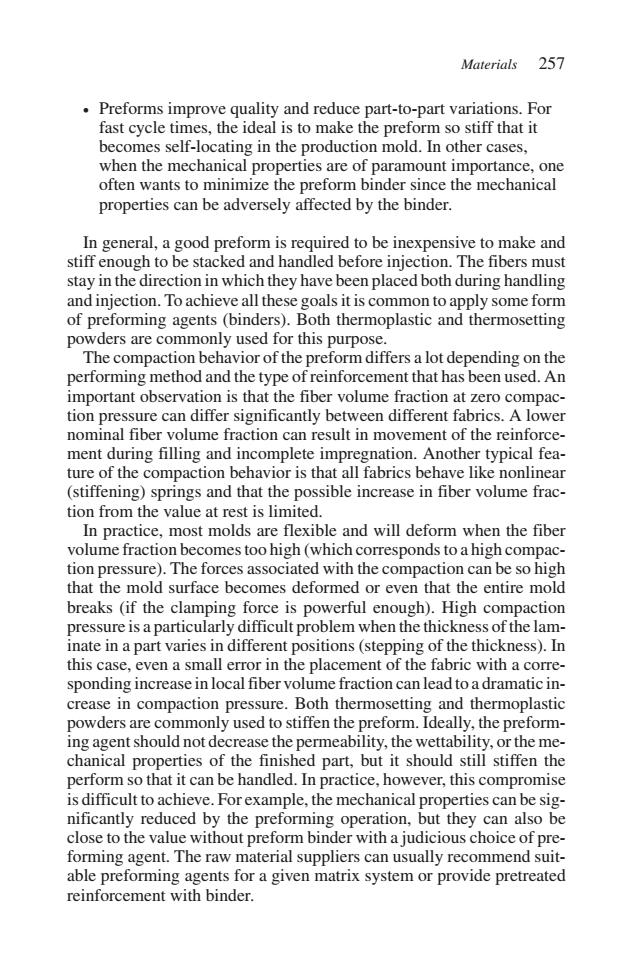正在加载图片...

Materials 257 Preforms improve quality and reduce part-to-part variations.For fast cycle times,the ideal is to make the preform so stiff that it becomes self-locating in the production mold.In other cases, when the mechanical properties are of paramount importance,one often wants to minimize the preform binder since the mechanical properties can be adversely affected by the binder. In general,a good preform is required to be inexpensive to make and stiff enough to be stacked and handled before injection.The fibers must stay in the direction in which they have been placed both during handling and injection.To achieve all these goals it is common to apply some form of preforming agents(binders).Both thermoplastic and thermosetting powders are commonly used for this purpose. The compaction behavior of the preform differs a lot depending on the performing method and the type of reinforcement that has been used.An important observation is that the fiber volume fraction at zero compac- tion pressure can differ significantly between different fabrics.A lower nominal fiber volume fraction can result in movement of the reinforce- ment during filling and incomplete impregnation.Another typical fea- ture of the compaction behavior is that all fabrics behave like nonlinear (stiffening)springs and that the possible increase in fiber volume frac- tion from the value at rest is limited. In practice,most molds are flexible and will deform when the fiber volume fraction becomes too high(which corresponds to a high compac- tion pressure).The forces associated with the compaction can be so high that the mold surface becomes deformed or even that the entire mold breaks (if the clamping force is powerful enough).High compaction pressure is a particularly difficult problem when the thickness of the lam- inate in a part varies in different positions (stepping of the thickness).In this case,even a small error in the placement of the fabric with a corre- sponding increase in local fiber volume fraction can lead to a dramatic in- crease in compaction pressure.Both thermosetting and thermoplastic powders are commonly used to stiffen the preform.Ideally,the preform- ing agent should not decrease the permeability,the wettability,or the me- chanical properties of the finished part,but it should still stiffen the perform so that it can be handled.In practice,however,this compromise is difficult to achieve.For example,the mechanical properties can be sig- nificantly reduced by the preforming operation,but they can also be close to the value without preform binder with a judicious choice of pre- forming agent.The raw material suppliers can usually recommend suit- able preforming agents for a given matrix system or provide pretreated reinforcement with binder.• Preforms improve quality and reduce part-to-part variations. For fast cycle times, the ideal is to make the preform so stiff that it becomes self-locating in the production mold. In other cases, when the mechanical properties are of paramount importance, one often wants to minimize the preform binder since the mechanical properties can be adversely affected by the binder. In general, a good preform is required to be inexpensive to make and stiff enough to be stacked and handled before injection. The fibers must stay in the direction in which they have been placed both during handling and injection. To achieve all these goals it is common to apply some form of preforming agents (binders). Both thermoplastic and thermosetting powders are commonly used for this purpose. The compaction behavior of the preform differs a lot depending on the performing method and the type of reinforcement that has been used. An important observation is that the fiber volume fraction at zero compaction pressure can differ significantly between different fabrics. A lower nominal fiber volume fraction can result in movement of the reinforcement during filling and incomplete impregnation. Another typical feature of the compaction behavior is that all fabrics behave like nonlinear (stiffening) springs and that the possible increase in fiber volume fraction from the value at rest is limited. In practice, most molds are flexible and will deform when the fiber volume fraction becomes too high (which corresponds to a high compaction pressure). The forces associated with the compaction can be so high that the mold surface becomes deformed or even that the entire mold breaks (if the clamping force is powerful enough). High compaction pressure is a particularly difficult problem when the thickness of the laminate in a part varies in different positions (stepping of the thickness). In this case, even a small error in the placement of the fabric with a corresponding increase in local fiber volume fraction can lead to a dramatic increase in compaction pressure. Both thermosetting and thermoplastic powders are commonly used to stiffen the preform. Ideally, the preforming agent should not decrease the permeability, the wettability, or the mechanical properties of the finished part, but it should still stiffen the perform so that it can be handled. In practice, however, this compromise is difficult to achieve. For example, the mechanical properties can be significantly reduced by the preforming operation, but they can also be close to the value without preform binder with a judicious choice of preforming agent. The raw material suppliers can usually recommend suitable preforming agents for a given matrix system or provide pretreated reinforcement with binder. Materials 257